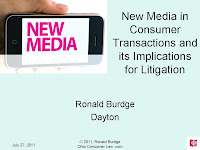For a different approach to handling a closing argument, here's an article that Elliott Wilcox has kindly allowed us to reprint here. It's a different idea to consider in your next case. If you don't subscribe to his Trial Tips Newsletter, I'd highly recommend it.
“The -Best- Closing Argument?”
by Elliott Wilcox
How do you structure your closing arguments? If you're like many attorneys, you probably take advantage of primacy to start strong and tell the jurors how strong your case is and show them why you deserve to win. Normally, that's exactly how I coach law students and trial lawyers to structure their closings. “Start strong,” I'll say, “disclose your weaknesses in the middle, and then finish strong.”
But... That's not necessarily the “best” way to outline your closing.
Trial advocacy is art. Unlike mathematics or science, where only one correct answer exists, art doesn't necessarily have a “best” way of doing something. Working from the same palette, Cézanne, Picasso and Dali each created radically different depictions of the human form, but none of their masterpieces can objectively be called “the best.”
The same is true of closing arguments. There are many different approaches, but we can't objectively say one of them is the “best” way of structuring an argument.
So, with that in mind, let me offer another approach for structuring your closing argument.
Rather than starting with your strongest argument, then saying “But, here's the weakness with our case,” you might want to consider starting with your case weakness before discussing the strongest part of your case. That's because the word “but” indicates, “Put aside what I just said, and pay attention to what I'm about to say.”
For example, let's pretend that during your semi-annual review, your boss tells you, “Overall, your job performance is excellent, but... your communication skills need improvement.”
If you're like most people, you probably fixated on the negative portion of the evaluation, even though the overall evaluation said you were doing an excellent job. It's just human nature - when we hear the word “but,” we tune out the previous statement and focus on what follows. Don't believe me? Just imagine the person you love most in the world telling you, “I love you more than anything else in the world. You're the most wonderful person I've ever met. I can't imagine life without you. But...”
All it takes is one word and you've completely forgotten about how wonderful you are, haven't you?
With that in mind, you may want to reconsider the structure of your closing argument. Many cases have been won with arguments that basically said, “We have a strong case that deserves to win... BUT, there are a few weakness in this case that you should know about.” If you're afraid this structure may increase the risk of jurors placing greater focus on your case weaknesses, you may want to re-write your argument like this: “There are a few weaknesses in this case that you should know about... BUT, we have a strong case that deserves to win.”
You probably won't want to try this format during opening statements, because at that point the jurors don't know anything about your case yet, and you'll want to fully maximize the power of Primacy by establishing a strong, positive image in your jurors' minds. However, by the time you reach closing arguments, the jurors have heard all of the testimony and seen all of the exhibits in your case, so Primacy doesn't play as big a role.
By the time you reach closings, the only thing left is argument. By discussing your weaknesses first before talking about the strength of your case, you may enhance your credibility with the jury and help them become more receptive to your arguments.
The important lesson is that there's no “best” way to craft your closing argument. Don't get locked into thinking there's only one way to structure your arguments or that there's a “magic bullet” that will work in every trial. Each trial is different, each client is different, and each jury is different. As the trial lawyer, it's your job to discover which structure you should use and which arguments you should make to create your “masterpiece” closing. Good luck!
Elliott Wilcox publishes Trial Tips Newsletter. Sign up today for your free subscription and a copy of his special reports: “How to Successfully Make & Meet Objections” and “The Ten Critical Mistakes Trial Lawyers Make (and how to avoid them)” at www.TrialTheater.com










